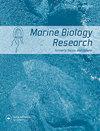海洋微藻盐小球藻对氮饥饿的生长和生化分析
IF 1.2
4区 生物学
Q4 ECOLOGY
引用次数: 1
摘要
摘要本研究旨在研究氮胁迫引起的海洋微藻小球藻的生化变化。藻类在无氮培养基(N−)中生长,通过测定蛋白质、脂质和碳水化合物来研究其最接近的组成。用气相色谱-质谱联用技术测定了该藻类的化学成分,并用电感耦合等离子体质谱法(ICP-MS)分析了其矿物含量。从结果来看,近似分析显示脂质增加(34.77 ± 0.6%),其次是碳水化合物(26.21 ± 0.2%)和蛋白质(5.4%干重)。用乙醚、己烷、氯仿、丙酮和甲醇依次提取盐藻的化学成分。不同溶剂的萃取率差异很大,甲醇的萃取率最高(4.68%)。从提取物中共鉴定出35种化合物,鉴定出的化学基团包括酮、萜烯、脂肪酸(FA)、脂肪醇和酯衍生的脂肪酸和/或二羧酸和碳氢化合物。甲醇提取物由FA(35%)、氨基酸和含氮代谢产物(7%)、脂肪醇(8%)、有机酸(3%)和碳氢化合物(80%)组成。藻类表现出高镁含量(54.079 mg/50 g) 然后是C(17.341 mg/50 g) ,S(5.702 mg/50 g) 和Na(3.275 mg/50 g) 。这些结果表明,氮含量和脂质积累之间有很强的相关性,因此表明盐小球藻可以作为生产生物柴油的潜在候选者。本文章由计算机程序翻译,如有差异,请以英文原文为准。
Growth and biochemical profiling of marine microalgae Chlorella salina with response to nitrogen starvation
ABSTRACT The present study aimed at investigating nitrogen stress-induced biochemical changes in the marine microalgae Chlorella salina. The algae were grown in N free medium (N − ) in order to study the proximate composition via the determination of protein, lipid and carbohydrate. The chemical constituents of this algae were determined using GC-MS and mineral content was analysed using Inductive Coupled Plasma-Mass Spectrometry (ICP-MS). From the results, the proximate analysis showed increased lipid (34.77 ± 0.6%), followed by carbohydrate (26.21 ± 0.2%) and protein (5.4% dry weight). The chemical constituents of C. salina were successively extracted with diethyl ether, hexane, chloroform, acetone and methanol. The extract percentage varied greatly between various solvents, with the highest one (4.68%) recorded for methanol. A total of 35 compounds were identified from the extracts and the identified chemical groups included ketones, terpenes, fatty acids (FA), fatty alcohols and esters derived fatty acids and/or dicarboxylic acid and hydrocarbons. The methanol extract consisted of FA (35%), amino acids and N-containing metabolites (7%), fatty alcohols (8%), organic acids (3%) and hydrocarbons (80%). The algae exhibited high amounts of Mg (54.079 mg/50 g) followed by C (17.341 mg/50 g), S (5.702 mg/50 g) and Na (3.275 mg/50 g). These results demonstrated a strong correlation between the nitrogen content and lipid accumulation, hence showing that Chlorella salina could serve as a potential candidate for biodiesel production.
求助全文
通过发布文献求助,成功后即可免费获取论文全文。
去求助
来源期刊

Marine Biology Research
生物-海洋与淡水生物学
CiteScore
2.10
自引率
0.00%
发文量
55
审稿时长
6-12 weeks
期刊介绍:
Marine Biology Research (MBRJ) provides a worldwide forum for key information, ideas and discussion on all areas of marine biology and biological oceanography. Founded in 2005 as a merger of two Scandinavian journals, Sarsia and Ophelia, MBRJ is based today at the Institute of Marine Research, Bergen, Norway. The Journal’s scope encompasses basic and applied research from all oceans and marine habitats and on all marine organisms, the main criterium for acceptance being quality.
 求助内容:
求助内容: 应助结果提醒方式:
应助结果提醒方式:


